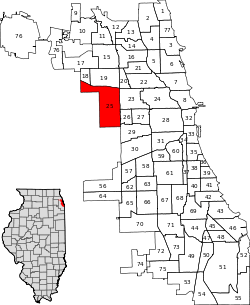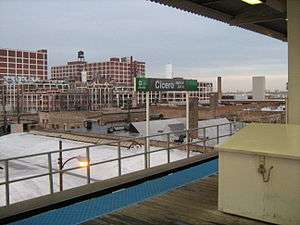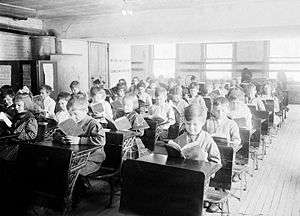Austin, Chicago
| Austin | |
|---|---|
| Community area | |
| Community Area 25 – Austin | |
 Location within the city of Chicago | |
| Coordinates: 41°54′N 87°45.6′W / 41.900°N 87.7600°WCoordinates: 41°54′N 87°45.6′W / 41.900°N 87.7600°W | |
| Country | United States |
| State | Illinois |
| County | Cook |
| City | Chicago |
| Neighborhoods | |
| Area | |
| • Total | 7.16 sq mi (18.54 km2) |
| Population (2010) | |
| • Total | 98,514 |
| • Density | 14,000/sq mi (5,300/km2) |
| Demographics 2010[1] | |
| • White | 4.43% |
| • Black | 85.1% |
| • Hispanic | 8.85% |
| • Asian | 0.58% |
| • Other | 1.03% |
| Time zone | CST (UTC-6) |
| • Summer (DST) | CDT (UTC-5) |
| Zip codes | 60644 and parts of 60635, 60639, 60651, 60707 |
| Area code(s) | 773, Cook Central,Daylight Time |
| Median household income | $32,358[2] |
| Source: U.S. Census, Record Information Services | |
Austin, located on the West Side of Chicago, Illinois, is the largest (by population) of the city's 77 officially defined community areas, followed by Lake View. Austin had a population of 98,514 in 2010. Austin is 85.1% Black.[3]
Austin's eastern boundary is the Belt Railway located just east of Cicero Avenue. Its northernmost border is the Milwaukee District/West Line. Its southernmost border is at Roosevelt Road from the Belt Railway west to Austin Boulevard. The northernmost portion, north of North Avenue, extends west to Harlem Avenue, abutting Elmwood Park. Other suburbs bordering Austin are Cicero and Oak Park. Also nearby is Berwyn.
Areas within Austin
Austin is also one of Chicago's largest community areas by land area. Several distinctive areas within Austin include Midway Park, a historic district of restored 19th-century single-family homes in the core of the original Austin subdivision, Galewood, the northernmost section of Austin along the northern border with Oak Park but south of the Galewood railcards.
Despite the massive scale change, the nineteenth-century village residential core is still visible in the Midway Park area north of Central and Lake, a designated National Register historic district (1985). This neighborhood boasts stately neoclassical and Queen Anne–style homes, many designed by architect Frederick Schock, as well as several structures by Frank Lloyd Wright and his students.
Galewood
Austin's far Northwestern edge is Galewood. Its borders are south at North Avenue, west at Harlem Avenue, east to Austin Avenue, and goes north to the Milwaukee District/West Line. It is historically an Italian neighborhood where residents of Taylor Street and Grand and Ogden moved to.
North Austin
One of Austin's neighborhoods is North Austin, its boundaries starts north at Milwaukee District/West Line and Armitage Avenue, Western boundaries are Austin Avenue or Austin Boulervard south of North Avenue, Eastern boundaries to Cicero Avenue, and Southern boundaries to Division Street.
South Austin
Austin's largest neighborhood is South Austin, extending from the Northern end of Division Street, Western edge of Austin Boulevard, goes east to Cicero Avenue, and all the way south to Roosevelt Road.
The Island
Austin includes The Island, Chicago a square mile in the extreme southwest corner of Austin, which is bordered by Cicero to the south and Oak Park to the west and which is isolated from other residential area in the city by the Eisenhower Expressway and Columbus Park to the north and an industrial area to the east.
The Island neighborhood is located on the far West Side of Chicago in the Austin community. It encompasses roughly a square mile and is adjacent to the municipalities of Oak Park and Cicero. Berwyn is also a few blocks away. When it was being developed in the early 20th century, it was separated from the rest of Austin by railroad tracks and Columbus Park to the north. To the east lies an industrial corridor, to the south is Cicero and to the west Oak Park – thus the name "The Island". Today The CTA Blue Line and The Eisenhower Expressway (290) share space with the railroad, making a convenient transportation hub for its residents.
George Rogers Clark Elementary School is in the Island community. The school's enrollment is roughly 400 students. Grade levels range from pre-kindergarten to eighth grade. Clark also provides classes for autistic and handicapped children. It is a diverse school given high achievement marks by the CPS. To keep students engaged in extra curriculum activities there are after-school programs and athletic activities, as well as Saturday Enrichment programs.
The Island is a walkable community with many businesses located on Roosevelt Road and the nearby Harrison Arts District in Oak Park.
L-Town
L-Town is a nickname for an area in Austin, although these long streets extend beyond the bounds of Austin, a few sources identify the name L-Town or L-Block as referring specifically to an area of Austin, from Cicero Avenue to the east and Central Avenue to the west, in which the names of many north-south avenues begin with the letter L (La Crosse, Lamon, Laporte, Lavergne, Lawler, Leclaire, Leamington, Laramie, Latrobe, Lockwood, Lorel, Long, Lotus, Linder, and Luna).
Crime
In 2015, the Chicago Police Department recorded 50 homicides in the Austin neighborhood, making the area the highest in homicide-related incidents in Chicago. By the Chicago Tribune (Crime in Chicagoland Page) the Austin neighborhood ranked 11th out of 77 Community areas in Chicago in violent crime, 25th among Chicago community areas in property crimes, and 5th out of 100 for quality of life crimes.[4]
The Austin neighborhood is notorious for gang violence, primarily caused by the Vice Lords, Four Corner Hustlers, Gangster Disciples, Black P. Stones, Bloods, and the Crips
History

Henry W. Austin, a businessman and real estate speculator, created the 280-acre (1.1 km2) Austin subdivision, located at 41°54′00″N 87°45′36″W / 41.90000°N 87.76000°W (41.9, −87.76), in 1865. Austin included wide, tree-lined streets and a park originally named Holden Park. Originally Austin was within the Township of Cicero. Cicero decided to place its seat of government in Austin, and in 1870 a town hall opened in Austin.[5]
In 1898 Austinites had a majority of Cicero's town council and used the political influence to approve an extension of the Lake Street elevated line into the community. People from other parts of Cicero Township, including Berwyn and Oak Park, resented the influence and the dominance of Austinites and began an election to have Austin annexed into Chicago. In 1899 the annexation succeeded. Austinites opposed the annexation.[6]
Austin was a predominantly white neighborhood until the late 1960s (99.83% white in the 1960 census). It faced numerous infrastructure problems before the arrival of black residents. White residents of Austin in the early 1960s were against leaving their neighborhood for the suburbs, but a combination of events occurred in the years afterward changed that. City of Chicago officials were not responsive to the neighborhood's demands for improving neighborhood infrastructure. Residents felt the need to move elsewhere because of disinvestment, mortgage redlining, and blockbusting throughout the neighborhoods of Austin.[7] The suburbs gradually became better supported through an increased transportation system between Chicago and its suburbs, and many jobs left the city for the suburbs and overseas locations.
Significant riots began to occur on Chicago's West Side starting in 1965, and the especially damaging 1968 Chicago riots (after Martin Luther King's death) prompted many white residents to leave. The West Side experienced a further declining infrastructure and lack of local jobs after this.
Not all emigrating residents moved into suburbs, and many moved into other areas of the city, especially the Northwest and Southwest sides. Not all emigrating residents were white: some black families, especially after the riots, began to leave the area, as it declined, to better perceived locations elsewhere.

By 1970, southern Austin (south of Lake St) was mostly black, and the neighborhood overall was 66% white and 33% black. Nearby neighborhoods such as East Garfield Park, West Garfield Park, and North Lawndale, were experiencing white flight before Austin did. Urban decay and a declining population in these neighborhoods led to an influx of black residents in Austin. By 1980, North Lawndale was 96.50% black and, West Garfield Park was 98.85% black, East Garfield Park was 99.00% black, and Austin was 20.76% white and 73.78% black.[8]
The population of these neighborhoods seriously declined in the 1970s (approximately 30–40% decline), except Austin, which increased from 128,000 residents in 1970 to 138,000 in 1980. The neighborhood is part of Chicago's West Side which consists of Austin, West Garfield Park, East Garfield Park, North Lawndale and Near West Side. The area has a population of about 250,000 and is over 87% black.[9]
On December 1, 1958, the Our Lady of the Angels School fire killed children and nuns at the Our Lady of the Angels School, located in the Humboldt Park community.[10] Because of the parish's proximity to Austin, many OLA students temporarily attended Austin schools, such as John Hay School.
On June 6, 2013 a lesbian couple was beaten by around 10 men on North Leclaire Ave in Austin. Chicago Police Department officials labeled the attack a hate crime, and one man received criminal charges.[11]
| Historical population | |||
|---|---|---|---|
| Census | Pop. | %± | |
| 1930 | 131,114 | — | |
| 1940 | 132,107 | 0.8% | |
| 1950 | 132,180 | 0.1% | |
| 1960 | 125,133 | −5.3% | |
| 1970 | 128,084 | 2.4% | |
| 1980 | 138,026 | 7.8% | |
| 1990 | 114,079 | −17.3% | |
| 2000 | 117,527 | 3.0% | |
| 2010 | 98,514 | −16.2% | |
| [12] | |||
Government and infrastructure
The United States Postal Service operates the Reverend Milton R. Brunson Station Post Office at 324 South Laramie Avenue and the Robert LeFlore, Jr. Post Office at 5001 West Division Street.[13][14] Another notable landmark is the Austin Town Hall Park Fieldhouse at 5610 W. Lake Street, modeled after Philadelphia's Independence Hall.
Education

Austin Community Academy High School[15] closed after Spring 2007.[16] New smaller schools have replaced Austin Community Academy High School: Austin Business and Entrepreneurship Academy, which opened in 2006, and Austin Polytechnical Academy, which opened in September 2007.[17]
Other portions of the community area are zoned to Manley H.S., Marshall H.S., and Orr Campus
Media
Austin is served by three free weekly newspapers. The West Cook Journal [18] founded in 2004, is published by West Suburban Journal, a black owned press published by Trottie Publishing, based in the West Cook County suburb of Westchester. The founder and publisher of West Suburban Journal and West Cook Journal, L. Nicole Trottie, is the first black woman in Illinois history to start an accredited weekly newspaper. Trottie is also the first African-American woman ever elected to the Illinois Press Association's Board of Director's in its 150-year newspaper rich history. The Austin Voice[19] has been published in Austin since 1988. The Austin Weekly News,[20] founded in 2005, is published by The Wednesday Journal, a publisher of free weekly newspapers based on Oak Park, Illinois. Both papers are published on Wednesdays and distributed in stores, office buildings and recreational venues throughout the community. Austin is also served by Austin Talks,[21] an online publication maintained by journalism students at Chicago's Columbia College and underwritten in part by the Chicago Community Trust.
Transportation
Two of Chicago Transit Authority's train lines, the Blue Line and the Green Line serve this neighborhood. The Green Line's stations in the neighborhood are Cicero, Laramie, Central, and Austin. The Blue Line's station in the neighborhood is Cicero.
References
- ↑ Paral, Rob. "Chicago Demographics Data". Archived from the original on June 2, 2013. Retrieved June 6, 2012.
- ↑ Paral, Rob. "Chicago Census Data". Archived from the original on October 5, 2013. Retrieved October 7, 2012.
- ↑ Paral, Rob. "Chicago Demographics Data". Archived from the original on June 2, 2013. Retrieved June 6, 2012.
- ↑ "Crime in Chicagoland – Austin". chicagotribune.com.
- ↑ "Austin Town Hall". Chicago Park District. Archived from the original on February 3, 2009. Retrieved December 30, 2008.
- ↑ "Austin Town Hall". Chicago Park District. Archived from the original on February 3, 2009. Retrieved December 30, 2008.
- ↑ Seligman, Amanda (2005). Block by block : neighborhoods and public policy on Chicago's West Side. Chicago: University of Chicago Press, ISBN 978-0-226-74663-0.
- ↑ American FactFinder. Factfinder.census.gov. Retrieved on 2013-07-21.
- ↑ American FactFinder. Factfinder.census.gov. Retrieved on 2013-07-21.
- ↑ Our Lady of the Angels School Fire – Period News Articles From around December 1, 1958. Olafire.com. Retrieved on 2013-07-21.
- ↑ Sege, Adam and Rex W. Huppke. "Hate crime draws attention to violence against lesbians, gays." Chicago Tribune. July 12, 2013. Retrieved on July 12, 2013.
- ↑ Paral, Rob. "Chicago Community Areas Historical Data". Archived from the original on March 18, 2013. Retrieved September 2, 2012.
- ↑ "Post Office Location – REV.MILTON R.BRUNSON STATION". United States Postal Service. Retrieved April 17, 2009.
- ↑ "Post Office Location – ROBERT LEFLORE JR.". United States Postal Service. Retrieved April 17, 2009.
- ↑ http://www.austin.cps.k12.il.us/
- ↑
- ↑ "New high school to focus on high-tech manufacturing". Chitowndailynews.org. May 31, 2007. Retrieved 2014-08-12.
- ↑ ]
- ↑ thevoicenewspapers.blogspot.com
- ↑ austinweeklynews.com
- ↑ austintalks.org
External links
| Wikimedia Commons has media related to Austin, Chicago. |
- Official City of Chicago Austin Community Map
- Chicago Landmarks
- Chicago Park District
- Austin Community Organizations and Service Providers
- Austin Weekly News, local newspaper
- Encyclopedia of Chicago entry on Austin
- Directory of Community Organizations Serving Austin, Chicago
